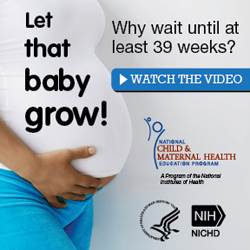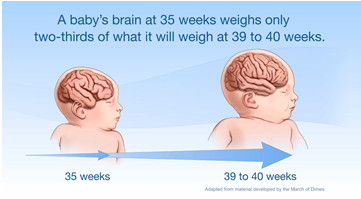NICHD Program Collaborates with Coordinating Committee Member Organizations To Spread the Word about Waiting until 39 Weeks to Deliver Unless Medically Necessary

Babies need at least 39 weeks to grow before they are born.
Research shows that outcomes for mothers who deliver their babies at or after 39 weeks of pregnancy, unless there is a medical reason to deliver earlier, and their babies are better than for those who deliver earlier. In a healthy pregnancy, it is safest for both baby and mother to allow the baby to remain in the womb at least 39 weeks.
It is very important for mothers and their healthcare provider to get this message because "elective" deliveries—planned, non-emergency deliveries on dates chosen by a woman and her health care provider—before 39 weeks increased by 50% in the United States between 1990 and 2006. The rates for elective delivery outpaced the medically indicated delivery rates.
"There is this sort of misconception that after 36 weeks, the babies are just 'fattening up.' But they are still learning how to breathe and their brains still developing," said Heather Spohr, the mom and blogger who is featured in the 4-minute video. "It's worth a little bit of discomfort to have a healthy baby." 
It's no small amount of growth and development, either: Babies' brains at 35 weeks of pregnancy weigh only 2/3 of what they weigh at 39 weeks. Lungs and liver also go through significant development up to 39 weeks.
But there are other risks associated with elective delivery before 39 weeks, for both mother and baby. The Program website offers more information about risks and benefits at http://www.nichd.nih.gov/ncmhep/initiatives/is-it-worth-it/Pages/health-care-providers.aspx.
Members of the NCMHEP Coordinating Committee include more than 30 of the nation's most prominent maternal health care provider associations, federal agencies, nonprofit maternal and child health organizations, and other partners. The Program identifies key challenges in child and maternal health and proposes solutions to advance the field based on the latest scientific evidence.
The NCMHEP Coordinating Committee joins the NICHD in promoting the videos through their organizations' social media channels, websites, and extensive networks of people interested in infant health, prematurity, and pregnancy issues. The NCMHEP is also working with Coordinating Committee members to promote the videos through a coordinated blog and social media rally that begins in the days leading up to Mother's Day. The Twitter components of the rally use the hashtag #babysetsthedate.
Spread the Word provides materials that organizations can use to let people know about the Is it worth it? initiative, including an electronic toolkit with an infographic of key statistics, Web buttons, e-cards, and other items. The videos are also available on the website.
Efforts to spread the word will continue after Mother's Day too. The 30- and 60-second videos will be shown in about 225 obstetrics/gynecology offices as part of Accent Health's network of waiting room health information channels starting at the end of May.
Just a couple weeks can make a big difference in the health of both mother and baby. The evidence is clear: It is worth it!
For more information, select a link below:
- NICHD Resources
- National Child and Maternal Health Education Program (NCMHEP)
- Is it worth it? initiative: https://www.nichd.nih.gov/ncmhep/initiatives/is-it-worth-it
- NCMHEP Coordinating Committee
- Previous NICHD Spotlights on NCMHEP:
- NICHD Related A-Z Topics:
- National Child and Maternal Health Education Program (NCMHEP)
Originally Posted: May 10, 2013

 BACK TO TOP
BACK TO TOP